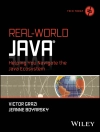‘This work strikes a balance between the pure functional aspects of
F# and the object-oriented and imperative features that make it so
useful in practice, enable .NET integration, and make large-scale
data processing possible.’
–Thore Graepel, Ph D, Researcher, Microsoft Research Ltd.
Over the next five years, F# is expected to become one of the
world’s most popular functional programming languages for
scientists of all disciplines working on the Windows platform. F#
is free and, unlike MATLAB® and other software with
numerical/scientific origins, is a full-fledged programming
language.
Developed in consultation with Don Syme of Microsoft Research
Ltd.–who wrote the language–F# for Scientists
explains and demonstrates the powerful features of this important
new programming language. The book assumes no prior experience and
guides the reader from the basics of computer programming to the
implementation of state-of-the-art algorithms.
F# for Scientists begins with coverage of introductory
material in the areas of functional programming, .NET, and
scientific computing, and goes on to explore:
* Program structure
* Optimization
* Data structures
* Libraries
* Numerical analysis
* Databases
* Input and output
* Interoperability
* Visualization
Screenshots of development using Visual Studio are used to
illustrate compilation, debugging, and interactive use, while
complete examples of a few whole programs are included to give
readers a complete view of F#’s capabilities.
Written in a clear and concise style, F# for Scientists
is well suited for researchers, scientists, and developers who want
to program under the Windows platform. It also serves as an ideal
supplemental text for advanced undergraduate and graduate students
with a background in science or engineering.
Table des matières
Foreword.
Preface.
Acknowledgments.
List of Figures.
List of Tables.
Acronyms.
1. Introduction.
1.1 Programming guidelines.
1.2 A brief history of F#.
1.3 Benefits of F#.
1.4 Introducing F#.
1.5 Imperative programming.
1.6 Functional programming.
2. Program Structure.
2.1 Nesting.
2.2 Factoring.
2.3 Modules.
2.4 Objects.
2.5 Functional design patterns.
2.6 F# development.
3. Data Structures.
3.1 Algorithmic complexity.
3.2 Arrays.
3.3 Lists.
3.4 Sets.
3.5 Hash tables.
3.6 Maps.
3.7 Choosing a data structure.
3.8 Sequences.
3.9 Heterogeneous containers.
3.10 Trees.
4. Numerical Analysis.
4.1 Number representation.
4.2 Algebra.
4.3 Interpolation.
4.4 Quadratic solutions.
4.5 Mean and variance.
4.6 Other forms of arithmetic.
5. Input and Output.
5.1 Printing.
5.2 Generic printing.
5.3 Reading from and writing to files.
5.4 Serialization.
5.5 Lexing and parsing.
6. Simple Examples.
6.1 Functional.
6.2 Numerical.
6.3 String related.
6.4 List related.
6.5 Array related.
6.6 Higher-order functions.
7. Visualization.
7.1 Windows Forms.
7.2 Managed Direct X.
7.3 Tesselating objects into triangles.
8. Optimization.
8.1 Timing.
8.2 Profiling.
8.3 Algorithmic optimizations.
8.4 Lower-level optimizations.
9. Libraries.
9.1 Loading .NET libraries.
9.2 Charting and graphing.
9.3 Threads.
9.4 Random numbers.
9.5 Regular expressions.
9.6 Vectors and matrices.
9.7 Downloading from the Web.
9.8 Compression.
9.9 Handling XML.
9.10 Calling native libraries.
9.11 Fourier transform.
9.12 Mataprogramming.
10. Databases.
10.1 Protein data bank.
10.2 Web services.
10.3 Relational databases.
11. Interoperability.
11.1 Excel.
11.2 MATLAB.
11.3 Mathematica.
12. Complete Examples.
12.1 Fast Fourier transform.
12.2 Semi-circle law.
12.3 Finding n th.-nearest neighbors.
12.4 Logistic map.
12.5 Real-time particle dynamics.
Appendix A: Troubleshooting.
A.1 Value restriction.
A.2 Mutable array contents.
A.3 Negative literals.
A.4 Accidental capture.
A.5 Local and non-local variable definitions.
A.6 Merging lines.
A.7 Applications that do not die.
A.8 Beware of ‘it’.
Glossary.
Bibliography.
Index.
A propos de l’auteur
Jon Harrop, Ph D, has taught mathematics, biology, and computer science. He founded Flying Frog Consultancy; has produced several products for computational scientists, including the book OCaml for Scientists; and has consulted for high-tech companies on the commercial use of functional programming languages.












